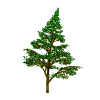 Conifers are the best known with the largest number of living species. They are woody trees or
shrubs. Most are evergreen and produce needlelike leaves. Most produce woody cones and they bear
seeds on exposed cone scales.
Conifers are the best known with the largest number of living species. They are woody trees or
shrubs. Most are evergreen and produce needlelike leaves. Most produce woody cones and they bear
seeds on exposed cone scales.Seed-bearing plants have three distinguishing characteristics:
Ovules are female reproductive structures that become seeds. They consist of a female gametophyte with an egg cell, plus nutrient-rich tissue, and a jacket of cell layers that will form a seed coat.
 Conifers are the best known with the largest number of living species. They are woody trees or
shrubs. Most are evergreen and produce needlelike leaves. Most produce woody cones and they bear
seeds on exposed cone scales.
Conifers are the best known with the largest number of living species. They are woody trees or
shrubs. Most are evergreen and produce needlelike leaves. Most produce woody cones and they bear
seeds on exposed cone scales.
Pine trees produce two kinds of spores in two kinds of cones. Male cones produce sporangia which yield microspores that develop into pollen grains (male gametophyte). Male cones are not woody and typically much smaller than female cones. You will miss them on a pine tree, unless you look closely.
Female cones are the typical woody pine cones and produce ovules that yield megaspores (female gametophyte). Pollination is the arrival of a pollen grain on the female reproductive parts, after which a pollen tube grows toward the egg. Fertilization, which is delayed for up to a year, results in a zygote that develops into an embryo within the conifer seed.
This animation (Audio - Important) describes the pine life cycle.
Conifers dominated during the Mesozoic. However, they reproduce more slowly than angiosperms and are at a competitive disadvantage in many habitats. They still dominate in the far North, at higher elevations, and in certain parts of the Southern Hemisphere.
Ginkgos are represented today by only one hardy species, Ginkgo biloba, that is native to China, and that has survived from the times of dinosaurs. The tree shows remarkable resistance to insects, disease, and air pollutants. It is a deciduous tree with fan-shaped leaves. Trees are male or female. Female trees produce seeds covered with a fleshy, foul-smelling coat. There are several Ginkgo trees on campus. You can find one on the north side of Haring Hall (or the south side of Storer Hall).
Cycads are palmlike trees that flourished during the Mesozoic era. Only about 185 species still exist, mainly confined to the tropics and subtropics. They bear massive cone-shaped strobili that produce either pollen (transferred by air currents or insects) or ovules. The pollen-bearing and seed-bearing cones are found on different plants.
Gnetophytes are the most unusual gymnosperms. They live in tropical and desert areas. Ephedra (joint fir, Mormon tea) is the best known of the three surviving genera. It is a natural source for the chemical ephedrine. Welwitschia has two long, prominent leaves. Gnetum has leaves that look similar to those of angiosperms.
Plant domestication began about 11,000 years ago, About 3,000 species have been used as food. Currently, about 200 plants are major crops.
There are many uses for plants in addition to food:
REVIEW: �Gymnosperms�
REVIEW: �Microspores mature into�
REVIEW: The conifers, such as pines and junipers, are examples of the��
REVIEW: Which of the following statements is NOT true?
a. Monocots and dicots are two classes of angiosperms.
b. Bryophytes are nonvascular plants.
c. Lycophytes and angiosperms are both vascular plants.
d. Gymnosperms are the simplest vascular plants.��
REVIEW: Which DOES NOT apply to gymnosperms and angiosperms?
a. vascular tissues
b. diploid dominance
c. single spore type
d. all of the above��
REVIEW: �A seed is _____ .�
PREVIOUS
NEXT
LECTURE 25 INDEX
MAIN INDEX